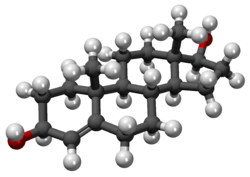4-Androstenediol
 | |
 | |
| Clinical data | |
|---|---|
| Other names | Androst-4-ene-3β,17β-diol |
| Routes of administration | Oral |
| Identifiers | |
| |
JSmol) | |
| |
| |
| | |
4-Androstenediol, also known as androst-4-ene-3β,17β-diol, is an
4-androstenedione, due to utilization of a different enzymatic pathway. There is also some conversion into estrogen
, since testosterone is the metabolic precursor of the estrogens.
4-Androstenediol is closer to
full agonists like testosterone or dihydrotestosterone (DHT), 4-androstenediol has antagonistic actions, behaving more like an antiandrogen.[1]
4-Androstenediol is very weakly
ERβ, respectively.[2]
Medical and commercial use
Patrick Arnold holds a 1999 patent on "Use of 4-androstenediol to increase testosterone levels in humans".[3]
References
- ^ S2CID 53267316.
- PMID 9048584.
- ^ "Use of 4-androstenediol to increase testosterone levels in humans". Archived from the original on 2011-03-18. Retrieved 2011-03-18.
